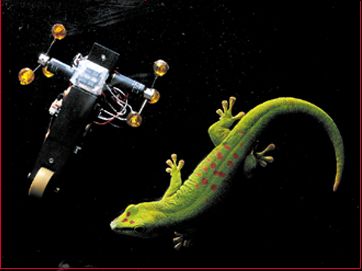


The tips of the gecko's toes are covered with corrugations of fantastic
complexity - it's as if they had the world's most complex fingerprints,
with the world's most prominent grooves and ridges. Actually, the corrugations
are lines of tiny hairs. Flattened in the right way against a surface,
the hairs lie so tightly on the surface that the gecko's toes literally
forma kind of chemical bond with it. (In technical terms, the gecko takes
advantage of van der Waals force.) Planting their feet down and peeling
them up, geckos can stick to walls and ceilings - a phenomenon that intrigues
researcher Alan DiPietro, of iRobot, in Somerville, Mass. Clinging to
the glass wall of a terrarium opposite a real gecko, DiPietro's crude,
13 centimeter-long, 100-gram Mecho-gecko has sticky feet that let it clumsily
cling to walls, at least for short intervals. The $600 creature is built
out of Delrin, powered by batteries, and guided by remote control - the
machine has no sensors to interpret its environment. A second, somewhat
similar machine has sticky tracks like a bulldozer; it's called a "bull-gecko."
The iRobot company built both devices in the hope of obtaining the funding
to build more sophisticated models. In the Mecho-Gecko's case, the new
model will have micromachined striations in its feet that mimic the surface
of geckos' feet.
Purpose
Provide mobility to small-sensor package, extend
range of operator's senses by climbing to high vantage point
Creative
Inspiration
Gecko lizard's climbing and attachment abilities
Height
6.3 cm
Length
11.4 cm
Weight
18 g
Vision
None
Sensors
None
Frame
Composition
Delrin
Batteries
Lithium primary
External
Power
None
KLOC
0
Cost
$600
Project Status
Ongoing
Information Source
Alan DiPietro


